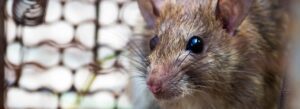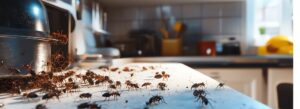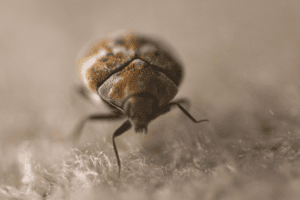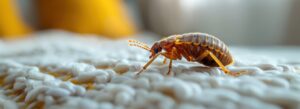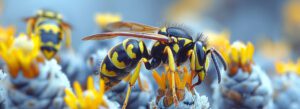Written by Innovation Pest Control, Kent
Introduction
During the summer months in the UK, particularly after a spell of heat and humidity, many homeowners are startled by sudden swarms of winged insects. This often leads to the same question:
“Is this a wasp or a flying ant?”
At Innovation Pest Control, we receive hundreds of enquiries every summer about strange winged insects around gardens, patios, or in the home. Some are wasps—most commonly Vespula vulgaris, paper wasps, or even the occasional parasitoid wasp. Others are flying ants, often part of a mature ant colony engaging in a nuptial flight.
Despite their similarities, these insects differ greatly in biology, behaviour, risk, and treatment strategies. This article explores the differences in detail — from anatomy and eusociality to reproduction, lifecycle, and how to identify them when you’re unsure.
Core Differences at a Glance
| Trait | Wasp | Flying Ant |
|---|---|---|
| Body Shape | Slim waist (petiole), smooth, shiny | Chunky, elbowed waist, less defined petiole |
| Wings | Unequal (forewings longer) | Equal-length wings |
| Antennae | Straight | Bent/elbowed |
| Colour | Black and yellow (vespidae) | Dark brown or black |
| Behaviour | Can sting; aggressive | Harmless; clumsy flyer |
| Nesting | Builds external nests | Lives underground or in walls |
| Lifecycle trigger | Seasonal queen emergence | Nuptial flight for mating |
| Risk | Stings; potential allergen | Nuisance; potential for termite-like damage if indoors |
Entomology 101: What Are They?
Wasps
Wasps belong to the suborder Apocrita within the insect phylum Arthropoda, and most UK species are members of the family Vespidae. This includes:
- Vespula vulgaris (common wasp)
- Vespula germanica (German wasp)
- Dolichovespula species
- Polistes species (paper wasp)
- Eumeninae (potter wasps)
- Scoliidae and Sphecidae
Wasps are typically carnivorous or omnivorous, feeding on other insects and nectar. Many species are considered beneficial because they engage in predation of pests like aphids, beetles, caterpillars, and even bed bugs.
Some wasps, like the parasitoid wasp, use parasitism to reproduce — laying eggs inside or on a host insect. The resulting larva feeds on the host from the inside, eventually killing it.
Flying Ants
Flying ants are not a separate species — they’re the reproductive caste of mature ant colonies. This behaviour is common to species in the Formicidae family, including:
- Lasius niger (black garden ant)
- Formica rufa (wood ant)
- Myrmica rubra (red ant)
- Leafcutter ants and fire ants (rare in UK, but relevant globally)
Only winged queen ants and drones (males) fly during the nuptial flight. Once mating occurs, the males die, and the queen sheds her wings and starts a new colony underground.
Ants are also eusocial, like wasps and bees, forming complex societies with castes — workers, drones, and reproductive queens.
Behavioural Differences
Temperament and Defence
- Wasps are territorial and aggressive. They use their stinger defensively and offensively. Many species can sting repeatedly.
- Flying ants, on the other hand, are docile. They’re focused on reproduction, not attack. Most UK ants don’t sting, although species like the fire ant or red imported fire ant (not native to the UK but present in the United States) do have painful bites and stings.
Movement and Flight
- Wasps exhibit agile, targeted flight behaviour, often hovering near plants, fruit, or food sources.
- Flying ants appear clumsy. Their wings beat out of sync, causing a jittery, erratic motion. Their pheromone communication during nuptial flight draws thousands into the air at once.
Feeding Habits
- Wasps feed on nectar, sugary foods, other insects, and even meat.
- Ants primarily feed on sugar, pollen, and proteins — including decaying animal matter or plant secretions.
Flying ants aren’t interested in food during their flight — their sole goal is fertilisation and reproduction.
Life Cycle & Reproduction
Wasps
- Eggs laid by a single queen
- Hatch into larva, then pupa
- Become workers, drones, or new queens
- Lifespan: Weeks (worker), Months (queen)
Flying Ants
- Only emerge from mature ant colonies
- Participate in nuptial flight
- Queen ant mates with several males mid-air
- Sheds wings and begins laying eggs underground
- Lifespan: Weeks (male), Several years (queen)
Ants also practise inbreeding avoidance by using widespread flight and pheromones to attract unrelated mates.
Ecological Role & Evolution
Wasps and ants both evolved from a common apoidea ancestor, sharing traits with halictidae, colletidae, and apidae families (bees). In fact, cuckoo bees, carpenter bees, mason bees, and bumblebees are all part of the evolution of these fascinating social insects.
- Wasps are both predators and pollinators
- Ants contribute to soil aeration, seed dispersal, and mutualism with other insects (like aphid farming)
Some ant species, like leafcutter ants, maintain underground fungus farms, a behaviour unmatched in most of the animal kingdom. Others, like formica rufa, play a role in plant and tree health by preying on destructive larvae.
Both wasps and ants are studied extensively in entomology and evolutionary biology.
Risk to Property and People
Wasps
- Can build nests in lofts, wall cavities, sheds
- May sting humans or pets multiple times
- Can trigger severe allergic reactions
- More dangerous as nests mature (July–September)
Flying Ants
- Usually harmless
- May cause alarm during nuptial flight
- Repeated emergence indoors could signal deeper issues
- Potential damage if nesting in wood, insulation, or near wiring (like termite damage)
A persistent flying ant presence inside your home is not just a nuisance — it’s a sign the colony may be growing inside structural elements.
How to Identify Them
Wasps
- Long, smooth, shiny body
- Bright yellow and black bands
- Straight antennae
- Narrow petiole (waist)
- Unequal wing pairs
Flying Ants
- Elbowed antennae
- Thicker, segmented body
- Wings of equal length
- Less shiny, more matte appearance
- Present only during nuptial flights
When to Call Innovation Pest Control
You should get in touch if:
- You can’t tell whether you’re dealing with wasps or ants
- You see repeated flying ant swarms indoors
- You or your pets are getting stung
- You suspect a wasp nest in your loft, shed, or garden
- You notice ants near foundations, wall voids, or damp wood
We’re experienced with all UK wasp species, ant species, and unusual stinging or nesting insects — including horntail, sawfly, mutillidae, and even spider wasps.
Services We Offer
- Fast, safe wasp nest removal
- Flying ant identification and treatment
- Nest site inspection (internal and external)
- Loft, wall cavity, and foundation inspections
- Discreet service for schools, businesses, and homes across Kent
Areas We Cover
- Ashford
- Maidstone
- Canterbury
- Medway
- Tenterden
- Folkestone
- All surrounding villages
Final Thoughts
Flying ants and wasps may look similar, but they behave very differently — and present very different risks. While one may be a harmless sign of natural reproduction, the other could be a colony of aggressive insects nesting in your home.
If you’re unsure, don’t guess. We’re here to help — quickly, safely, and professionally.
Innovation Pest Control
Call: 07743 958 655
Visit: https://innovationpestcontrol.co.uk


